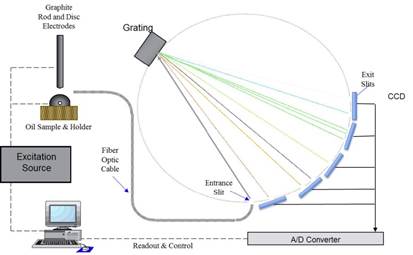元素
元素
概述
评估设备的磨损状况是状态监测的主要内容。用油设备在其整个使用寿命期间内都会产生磨损颗粒,磨损的性质和速度由于其初始磨损原因,最终报废诱因等种种因素的不同而相同。光谱可被用于检测磨损及其严重程度。光谱分析是可量化检测油样中元素的技术。光谱分析利用每个元素具有独特原子结构的特点。当受到能量激发时,元素都会发出特定波长的光。由于没有两个元素能发射出相同波长的光,所以可以据此区分这些元素。发射光的强度与样品中存在的元素量成正比,通过测定发射光的强度可以确定该元素的浓度。通常,这些技术的名字来源于其激发元素的方法。
油液分析最常用技术
►电弧/火花/旋转圆盘电极光谱(RDE)
放电是现代光谱仪中用于激发的典型方法。该激发方法旨在将电弧或火花中的能量传递给样品。油品检测分析光谱仪的两个电极之间会形成一个很大的电势。常用的电极有两种:固定钨或银电极;圆盘和棒状石墨电极。两者都在它们的间隙中对油样进行放电。电容器存储的电荷通过该间隙放电,产生高温电弧,使样品的一部分汽化,形成等离子体。该过程发出的光是由样品中存在的所有元素发出的。

可以将这些发射光分离成单独波长的光,并通过合理设计的光学系统进行测量。石墨电极(旋转圆盘RDE)技术在世界各地被广泛应于油品分析,其采用美国国防部联合石油分析计划(JOAP)的标准,JOAP也被许多其他组织采用,这些组织希望平衡其与实验室的多种类元素分析 的易用性和可靠性。
RDE光谱仪可以在不到一分钟的时间内同时分析多达31种元素,无需使用溶剂或气体。这种易用性,和3%至6% RSD的可重复性,使其成为状态监测团队的可靠选择。通常,系统放置于车间或与实验室环境相比不太理想的环境中,在这种环境中它们也可以可靠地运行多年。
这种技术的另一种变体是使用固定的钨或银电极。这种方法通常用于流通系统,该系统按顺序对油样进行许多分析测试。这些流通系统的目的是结合多种类型的油的分析测试结果,获得油品状况的完整情况,包括磨损颗粒,化学成分,粘度和受污染情况等信息。这些系统通常会牺牲一些可重复性和准确性,以便在运行全套油品测试时体现易用性。
►X射线荧光光谱(XRF)
另一种方法是使用X射线来激发样品。足够高能量的X射线会激发出元素内的电子。空位会被具有较高能级的电子填充。为了向下移动到较低的能级,这些电子会以发射X射线的形式降低能量。元素发射的X射线具有特有的能量。射线强度与元素浓度成正比。
对于元素的常规检测,可使用能量色散XRF仪器。XRF的一个常见用途是通过检查添加剂浓度来实现新油的品质控制。在制备液体样品,首先拉伸在聚乙烯圆筒两端的聚酯薄膜,在夹紧顶部薄膜盖之前,小心地将油样品置入圆筒中。然后将其放置到样品室中并照射,照射时间取决于设置的条件和所需的精度,通常为3至5分钟。检测高浓度添加剂时,XRF与原子光谱契合得非常好,但是当检测磨损金属尤其是当其悬浮在油中的情况时,光谱法仍然是主流选择。
►原子吸收光谱仪(AAS)
原子吸收(AA)光谱仪是一种成本低但却具有出色灵敏度的光谱仪,通常在仅监测少数几种元素时使用。这种技术依赖于原子吸收,原子将吸收波长为它们在被激发时发出光的波长的光。可用溶剂稀释或酸消解制备油样,样品通过雾化器雾化并导入氧乙炔和一氧化二氮乙炔火焰中。辐射源,如空心阴极射线管,为被检测的元素提供光,光通过火焰被引导到探测器中。如果样品中不存在任何元素,则通过火焰并在检测器处检测到的光量是最大的。随着目标元素(来自油样)的浓度增加,光会被吸收,检测器检测量随之减小。如果样品中不存在任何元素,则通过火焰的光不会被吸收,并且可在检测器处测量到所有入射光。
►电感耦合等离子体光谱(ICP)
另一种广泛用于水溶液和油样的光谱仪是电感耦合等离子体(ICP)光谱仪。在这种仪器中,流经石英管(或工业术语中的“torch”)的氩气通过缠绕在石英管周围的铜线圈携带的快速交变电流被激发到非常高的温度。等离子体是一种炽热的、高度电离的气体,会发出强烈的光。等离子体由电火花激发,电火花可以电离一部分氩气。
油样分析实验室用于常规油品分析的最常见方法是“稀释并雾化”方法。用煤油稀释油样(通常煤油与油的比例为9:1),并用喷雾室雾化以产生气溶胶喷雾。只有1%的样品被泵送到torch并在等离子体中通电。该技术具有高精度和出色的可重复性(RSD小于3%)。然而,这种技术不能分析大于5微米的颗粒。因此需要用微波酸消解进行额外的样品制备。处理样品所需的时间(通常每个样品2分钟)使该技术不适合手动进样,因此通常使用自动进样器。该技术常用于大批量分析实验室,在这些实验室中,有干净的氩气和专门的技术人员随时可用。每月使用氩气的成本可能超过1000美元,并且需要在大型杜瓦瓶中储存或散装储存。即使仪器并未使用,氩气也会消耗(用于光学仪器)。ICP光谱仪是主力,但其维护成本很高。当样品量大于 250 个/天时才能平衡维持系统的管理成本。
总结
测量油样中磨损金属的方法有很多,每种方法都有其优点和局限性。在确定解决方案之前,要先确定检测的范围,所要检测的磨损金属类型,样品量和可用的资源。
油品的光谱分析适用于任何闭环润滑系统,例如柴油和汽油发动机、燃气轮机、变速器、齿轮箱、压缩机和液压系统。在实践中,需要定期从被监测设备中取出油样。所选的光谱仪需要能分析样品中磨损金属的水平,以及外来污染和添加剂的水平。将所得到的数据与先前分析结果和允许极限进行比较,可以确定设备是否出现了严重的问题。在考虑使用光谱仪测量磨损金属时,需要注意以下几点:
- 尝试测量的设备和油样中的各种元素,污染物和添加剂的种类。
- 需要测量的元素的范围和性能。。
- 在给定时间内需要测试的样本数量。
获取免费电子指南并了解更多信息
下载电子指南
